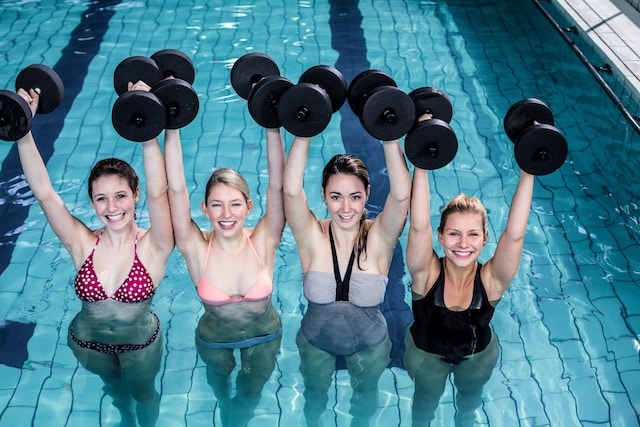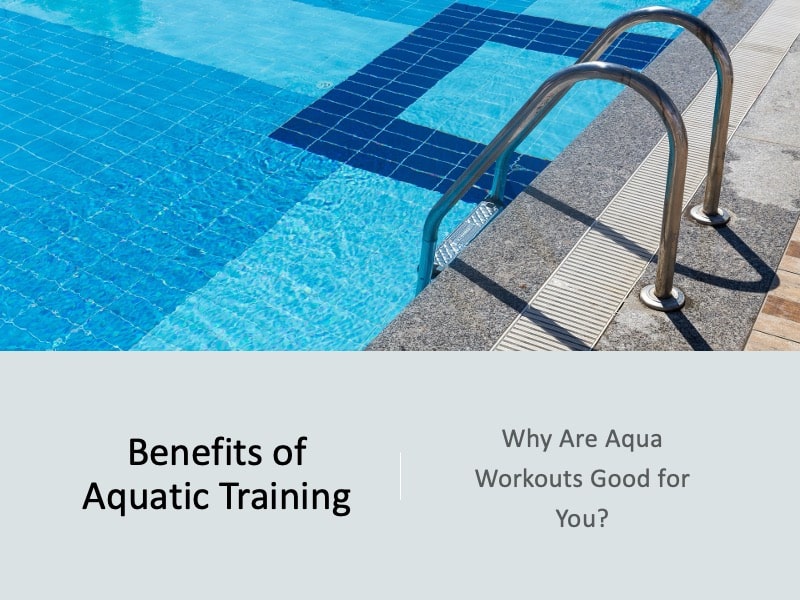Benefits of Aquatic Training: Why Are Aqua Workouts Good?
I first discovered aquatic training back in prep school, thanks to my teammate Anthony Ireland. Anthony was barely 5’10”, yet he was dunking with incredible explosiveness—an ability he credited to his aquatic plyometric routine.
Intrigued, I decided to give it a try. From aqua cycling to underwater running and swimming, I explored every type of water-based workout I could find.
Each added something new to my game: explosive power, joint-friendly cardio, and the endurance needed for a long basketball career.
Aquatic training offers an incredible, low-impact way to improve fitness, making it ideal for everyone from athletes to seniors and those recovering from injury.
From strength and endurance to flexibility and joint health, water workouts provide a unique advantage by combining resistance with a joint-friendly environment.
Additionally, integrating aquatic training into your routine can help you achieve a stronger, more balanced body, benefiting you both in and out of the water.
Today, after more than a decade in professional basketball, I can say aquatic training has been a game-changer for me and is a fantastic option for athletes and fitness enthusiasts alike.
The benefits of training in water—from strength and flexibility to low-impact endurance—make it an ideal approach for anyone looking to stay fit and perform at their best.
Benefits of Aquatic Training
Aquatic training is unique in offering high resistance without the joint strain associated with many traditional exercises. Here are some key advantages:
- Low Impact, High Resistance
Water provides natural resistance while reducing joint strain, making it ideal for high-impact exercises without the usual wear and tear (Carayannaopoulos et al., 2020). This dual benefit is especially valuable for people managing injuries or chronic conditions. - Enhanced Cardiovascular and Muscular Endurance
Water resistance challenges the cardiovascular system and enhances endurance. Studies show that aquatic training can improve aerobic capacity on par with land-based exercises, providing an effective workout that minimizes risk (Kwok et al., 2022). - Improved Flexibility and Range of Motion
Warm water promotes muscle relaxation, increasing flexibility and range of motion, which is beneficial for both injury prevention and recovery. - Muscle Activation and Functional Strength
Training in water requires activating multiple muscle groups simultaneously to maintain balance and control, which translates into improved functional strength and stability.
Types of Aquatic Training
Aquatic training harnesses water’s unique properties—buoyancy, resistance, and a low-impact environment—to create effective workout routines for athletes, fitness enthusiasts, and individuals recovering from injuries.
In contrast to land-based exercises, water-based workouts offer a diverse range of benefits, from reduced joint strain to enhanced flexibility and endurance.
These exercises are suitable for all fitness levels and can be adapted to achieve different goals, from building strength and cardiovascular endurance to improving balance and rehabilitation.
Whether through high-intensity plyometrics, strength training, or therapeutic exercises, aquatic training offers a holistic approach to fitness that supports physical resilience and overall well-being.
Aquatic Strength Training

Aquatic strength training uses resistance tools such as water dumbbells, resistance bands, and paddles to target muscle groups and build endurance.
The water provides constant resistance, requiring continuous muscle engagement, which helps tone and strengthen muscles differently than on land.
Movements like underwater squats, lunges, bicep curls, and presses activate the core and stabilizing muscles while reducing the risk of injury.
This type of training is ideal for those looking to increase strength, endurance, and muscle tone without putting excessive strain on joints and ligaments.
For example, people who are treating knee pain from arthritis can do a quality workout in the pool that strengthens knee muscles without pain or discomfort.
Aqua Cardio
Cardio-focused aquatic workouts, such as aqua jogging, aqua cycling, pool running, and water aerobics, deliver an effective cardiovascular workout with minimal impact on the body’s joints.
These exercises provide all the heart-health benefits of traditional cardio routines but in a gentler environment.
Water-based HIIT (High-Intensity Interval Training) adds another layer of challenge by incorporating intense bursts of movement with short recovery intervals.
Combining cardio with strength elements, these workouts can boost cardiovascular health, improve endurance, and aid in weight management, making them ideal for both high-performance athletes and those new to exercise.
Aqua Pilates and Yoga
Aqua Pilates and yoga use the body’s buoyancy in water to create a stable, yet subtly challenging, environment that encourages deeper muscle engagement and focus.
Movements in water, such as stretches, twists, and poses, engage the core more effectively as the water constantly shifts around the body.
This helps enhance flexibility, balance, and body awareness, contributing to overall functional strength and posture.
By reducing joint strain, aquatic Pilates and yoga provide a low-risk environment for increasing range of motion, making them beneficial for all fitness levels, from beginners to advanced practitioners.
Aquatic Physical Therapy
Aquatic physical therapy is widely used in rehabilitation programs for individuals recovering from injuries or managing chronic pain.
The buoyancy of water allows for a greater range of motion without the pressure and discomfort associated with traditional physical therapy.
Water’s natural resistance enhances muscle engagement, helping rebuild strength and mobility gradually.
Exercises such as water walking, leg lifts, and gentle stretches can help restore joint function and reduce inflammation, making aquatic therapy ideal for individuals recovering from surgeries, arthritis, or other conditions affecting mobility.
Aquatic Plyometrics
Aquatic plyometrics bring the explosiveness of land-based jumping exercises into the water, providing a unique way to build power, improve muscle responsiveness, and increase your vertical jump.
The water’s resistance reduces the impact on joints and minimizes the risk of injury while still engaging major muscle groups.
Exercises like jump squats, bounding leaps, and lateral jumps are performed in the water, challenging muscles to work against the natural drag.
This type of plyometric training is especially useful for athletes looking to enhance leg strength, agility, and reaction time without the strain of high-impact movements on land.
Useful Equipment for Aquatic Training
- Water Dumbbells
Foam water dumbbells increase resistance for strength exercises, making them ideal for aquatic strength training routines. - Aqua Jogging Belt
These belts provide buoyancy for deep-water running, helping users maintain proper form while focusing on cardiovascular endurance. - Kickboards and Pull Buoys
For swimming drills and core exercises, kickboards and pull buoys are excellent tools that support targeted muscle activation. - Water Resistance Bands and Gloves
Resistance bands designed for water add an extra challenge for muscle toning, while gloves with webbing enhance hand resistance, perfect for upper body workouts.
Who Should Do Aquatic Training Workouts?
Aquatic training’s versatility makes it valuable for different fitness levels and needs:
Athletes
Water-based exercises are excellent for cross-training and recovery, giving athletes a way to build strength and endurance without added joint stress.
This makes it ideal for recovery days or as a supplement to high-impact training.
Seniors
As we age, maintaining joint health becomes increasingly important.
Aquatic training provides a safe, effective way for seniors to exercise and improve strength, mobility, and cardiovascular health without high impact.
Injury Rehabilitation
Aquatic training is particularly beneficial for those recovering from injury. Water exercises allow for safe, pain-free movement while regaining strength and flexibility, accelerating recovery.
Safety Tips
- Prioritize Form
While water reduces impact, maintaining proper form is crucial. Poor form can reduce exercise effectiveness, so focus on engaging the right muscles and moving deliberately. - Stay Hydrated
It’s easy to overlook hydration during water workouts, but you still lose fluids. Make sure to drink water before, during, and after training. - Adjust Resistance with Speed
In water, the faster you move, the more resistance you encounter. To increase difficulty, speed up the movements while maintaining control, especially for advanced workouts. - Warm Up and Cool Down
Just like any workout, warming up and cooling down are essential to prepare your muscles and prevent stiffness.
Frequently Asked Questions (FAQs) about Aquatic Training
Q: Is aquatic training suitable for weight loss?
Yes, aquatic training burns calories due to water’s natural resistance, making it an effective workout for weight loss and toning.
Q: Can aquatic training help with balance and coordination?
Absolutely. Water’s buoyancy challenges balance and coordination in a way that strengthens stabilizer muscles and core control.
Q: How often should I do aquatic training?
Depending on your fitness goals, 2-3 sessions a week can be beneficial for general fitness, while athletes may incorporate it more frequently for recovery or cross-training.



